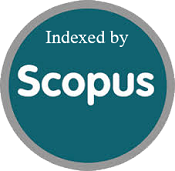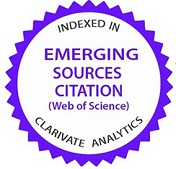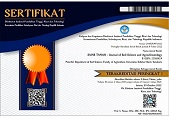Effect of biochar on microbial population in heavy metal contaminated soil for 23 years
Abstract
Keywords
Full Text:
PDFReferences
Abdi, H., & Williams, L. J. (2010). Principal component analysis. WIREs Computational Statistics, 2(4), 433-459. https://doi.org/10.1002/wics.101
Adejoh, I. P. (2016). Assessment of heavy metal contamination of soil and cassava plants within the vicinity of a cement factory in north central, Nigeria. Advances in Applied Science Research, 7(3), 20-27. https://www.primescholars.com/abstract/assessment-of-heavy-metal-contamination-of-soil-and-cassava-plants-within-the-vicinity-of-a-cement-factory-in-north-cent-90357.html
Aksu, A. (2015). Sources of metal pollution in the urban atmosphere (A case study: Tuzla, Istanbul). Journal of Environmental Health Science and Engineering, 13(1), 79. https://doi.org/10.1186/s40201-015-0224-9
Anand, P., Isar, J., Saran, S., & Saxena, R. K. (2006). Bioaccumulation of copper by Trichoderma viride. Bioresource Technology, 97(8), 1018-1025. https://doi.org/10.1016/j.biortech.2005.04.046
Aprile, A., & De Bellis, L. (2020). Editorial for Special Issue “Heavy Metals Accumulation, Toxicity, and Detoxification in Plants”. International Journal of Molecular Sciences, 21(11), 4103. https://doi.org/10.3390/ijms21114103
Arif, N., Yadav, V., Singh, S., Singh, S., Ahmad, P., Mishra, R. K., . . . Chauhan, D. K. (2016). Influence of High and Low Levels of Plant-Beneficial Heavy Metal Ions on Plant Growth and Development [Mini Review]. Frontiers in Environmental Science, Volume 4 - 2016. https://doi.org/10.3389/fenvs.2016.00069
Arnebrant, K., Bååth, E., & Nordgren, A. (1987). Copper Tolerance of Microfungi Isolated from Polluted and Unpolluted Forest Soil. Mycologia, 79(6), 890-895. https://doi.org/10.1080/00275514.1987.12025478
Asati, A., Pichhode, M., & Nikhil, K. (2016). Effect of heavy metals on plants: an overview. International Journal of Application or Innovation in Engineering & Management, 5(3), 56-66. https://doi.org/10.13140/RG.2.2.27583.87204
Baquy, M. A.-A., Mamun, M. A. A., Mia, S., Alam, M. M., Khan, M. S. H., & Rahman, S. M. (2022). Biochar research advancement in Bangladesh: challenges and opportunities of biochar in improving soil health. Sains Tanah Journal of Soil Science and Agroclimatology, 19(2), 15. https://doi.org/10.20961/stjssa.v19i2.59758
Chen, D., Liu, X., Bian, R., Cheng, K., Zhang, X., Zheng, J., . . . Li, L. (2018). Effects of biochar on availability and plant uptake of heavy metals – A meta-analysis. Journal of Environmental Management, 222, 76-85. https://doi.org/10.1016/j.jenvman.2018.05.004
Congeevaram, S., Dhanarani, S., Park, J., Dexilin, M., & Thamaraiselvi, K. (2007). Biosorption of chromium and nickel by heavy metal resistant fungal and bacterial isolates. Journal of Hazardous Materials, 146(1), 270-277. https://doi.org/10.1016/j.jhazmat.2006.12.017
Dietz, S., Herz, K., Gorzolka, K., Jandt, U., Bruelheide, H., & Scheel, D. (2020). Root exudate composition of grass and forb species in natural grasslands. Scientific Reports, 10(1), 10691. https://doi.org/10.1038/s41598-019-54309-5
Ebido, N. E., Edeh, I. G., Unagwu, B. O., Nnadi, A. L., Ozongwu, O. V., Obalum, S. E., & Igwe, C. A. (2021). Rice-husk biochar effects on organic carbon, aggregate stability and nitrogen-fertility of coarse-textured Ultisols evaluated using Celosia argentea growth. Sains Tanah Journal of Soil Science and Agroclimatology, 18(2), 11. https://doi.org/10.20961/stjssa.v18i2.56330
El-Maghrabi, H. H., & Mikhail, S. (2014). Removal of heavy metals via adsorption using natural clay material. Journal of Environment and Earth Science, 4(19), 38-46. https://www.iiste.org/Journals/index.php/JEES/article/view/16620
Febriansyah, M. R., Septiana, L. M., Supriatin, S., & Salam, A. K. (2021). The patterns of lead and copper levels in the vicinity of heavy metal sources in Lampung, the southern part of Sumatra, Indonesia. IOP Conference Series: Earth and Environmental Science, 739(1), 012001. https://doi.org/10.1088/1755-1315/739/1/012001
Gadd, G. M. (2016). 5 Fungi and Industrial Pollutants. In I. S. Druzhinina & C. P. Kubicek (Eds.), Environmental and Microbial Relationships (pp. 99-125). Springer International Publishing. https://doi.org/10.1007/978-3-319-29532-9_5
Gonzalez-Chavez, C., D'Haen, J., Vangronsveld, J., & Dodd, J. C. (2002). Copper sorption and accumulation by the extraradical mycelium of different Glomus spp. (arbuscular mycorrhizal fungi) isolated from the same polluted soil. Plant and Soil, 240(2), 287-297. https://doi.org/10.1023/A:1015794622592
Hayyat, A., Javed, M., Rasheed, I., Ali, S., Shahid, M. J., Rizwan, M., . . . Ali, Q. (2016). Role of Biochar in Remediating Heavy Metals in Soil. In A. A. Ansari, S. S. Gill, R. Gill, G. R. Lanza, & L. Newman (Eds.), Phytoremediation: Management of Environmental Contaminants, Volume 3 (pp. 421-437). Springer International Publishing. https://doi.org/10.1007/978-3-319-40148-5_14
Jamal, Q., Durani, P., Khan, K., Munir, S., Hussain, S., Munir, K., & Anees, M. (2013). Heavy metals accumulation and their toxic effects. Journal of Bio-Molecular Sciences (JBMS), 1(1-2), 27-36. https://www.researchgate.net/publication/276921553
Kelly, J. J., Häggblom, M. M., & Tate, R. L. (2003). Effects of heavy metal contamination and remediation on soil microbial communities in the vicinity of a zinc smelter as indicated by analysis of microbial community phospholipid fatty acid profiles. Biology and Fertility of Soils, 38(2), 65-71. https://doi.org/10.1007/s00374-003-0642-1
Khalisha, A., Widyastuti, R., & Chaniago, I. A. (2022). Use of phosphorus- and potassium-solubilizing multifunctional microbes to support maize growth and yield. Sains Tanah Journal of Soil Science and Agroclimatology, 19(1), 8. https://doi.org/10.20961/stjssa.v19i1.57816
Khodadad, C. L. M., Zimmerman, A. R., Green, S. J., Uthandi, S., & Foster, J. S. (2011). Taxa-specific changes in soil microbial community composition induced by pyrogenic carbon amendments. Soil Biology and Biochemistry, 43(2), 385-392. https://doi.org/10.1016/j.soilbio.2010.11.005
Khodijah, N. S., Suwignyo, R. A., Harun, M. U., & Robiartini, L. (2019). Phytoremediation potential of some grasses on lead heavy metal in tailing planting media of former tin mining. Biodiversitas Journal of Biological Diversity, 20(7). https://doi.org/10.13057/biodiv/d200725
Komkiene, J., & Baltrenaite, E. (2016). Biochar as adsorbent for removal of heavy metal ions [Cadmium(II), Copper(II), Lead(II), Zinc(II)] from aqueous phase. International Journal of Environmental Science and Technology, 13(2), 471-482. https://doi.org/10.1007/s13762-015-0873-3
Kozdrój, J. (1995). Microbial responses to single or successive soil contamination with Cd or Cu. Soil Biology and Biochemistry, 27(11), 1459-1465. https://doi.org/10.1016/0038-0717(95)00070-U
Kozdrój, J., & van Elsas, J. D. (2001). Structural diversity of microbial communities in arable soils of a heavily industrialised area determined by PCR-DGGE fingerprinting and FAME profiling. Applied Soil Ecology, 17(1), 31-42. https://doi.org/10.1016/S0929-1393(00)00130-X
Lahori, A. H., Mierzwa-Hersztek, M., Demiraj, E., Idir, R., Bui, T. T. X., Vu, D. D., . . . Zhang, Z. (2020). Clays, Limestone and Biochar Affect the Bioavailability and Geochemical Fractions of Cadmium and Zinc from Zn-Smelter Polluted Soils. Sustainability, 12(20), 8606. https://doi.org/10.3390/su12208606
Lekfeldt, J. D. S., Holm, P. E., Kjærgaard, C., & Magid, J. (2017). Heavy Metal Leaching as Affected by Long-Time Organic Waste Fertilizer Application. Journal of Environmental Quality, 46(4), 871-878. https://doi.org/10.2134/jeq2016.11.0458
Lu, H., Li, Z., Fu, S., Méndez, A., Gascó, G., & Paz-Ferreiro, J. (2015). Combining phytoextraction and biochar addition improves soil biochemical properties in a soil contaminated with Cd. Chemosphere, 119, 209-216. https://doi.org/10.1016/j.chemosphere.2014.06.024
Meena, A., & Rao, K. S. (2021). Assessment of soil microbial and enzyme activity in the rhizosphere zone under different land use/cover of a semiarid region, India. Ecological Processes, 10(1), 16. https://doi.org/10.1186/s13717-021-00288-3
Mwangi, L., & Lelei, D. (2023). Standard operating procedure: Method forisolation and enumeration of bacteria and fungi ratios. World Agroforestry Centre,. https://www.cifor-icraf.org/resources-documents/Method-for-Isolation-and-Enumeration-of-Bacteria-and-Fungi.pdf
Nie, C., Yang, X., Niazi, N. K., Xu, X., Wen, Y., Rinklebe, J., . . . Wang, H. (2018). Impact of sugarcane bagasse-derived biochar on heavy metal availability and microbial activity: A field study. Chemosphere, 200, 274-282. https://doi.org/10.1016/j.chemosphere.2018.02.134
Paneque, M., De la Rosa, J. M., Franco-Navarro, J. D., Colmenero-Flores, J. M., & Knicker, H. (2016). Effect of biochar amendment on morphology, productivity and water relations of sunflower plants under non-irrigation conditions. CATENA, 147, 280-287. https://doi.org/10.1016/j.catena.2016.07.037
Patra, J. M., Panda, S. S., & Dhal, N. K. (2020). Biochar as a low-cost adsorbent for heavy metal removal: A review. International Journal of Research in BioSciences (IJRBS), 6(1), 1-7. https://www.ijrbs.in/index.php/ijrbs/article/view/232
Pawlowska, T. E., & Charvat, I. (2004). Heavy-Metal Stress and Developmental Patterns of Arbuscular Mycorrhizal Fungi. Applied and Environmental Microbiology, 70(11), 6643-6649. https://doi.org/10.1128/AEM.70.11.6643-6649.2004
Pérez-de-Mora, A., Burgos, P., Madejón, E., Cabrera, F., Jaeckel, P., & Schloter, M. (2006). Microbial community structure and function in a soil contaminated by heavy metals: effects of plant growth and different amendments. Soil Biology and Biochemistry, 38(2), 327-341. https://doi.org/10.1016/j.soilbio.2005.05.010
Popova, E. (2016). Accumulation of heavy metals in the “soil-plant” system. AIP Conference Proceedings, 1772(1). https://doi.org/10.1063/1.4964576
Qu, Y., Tang, J., Li, Z., Zhou, Z., Wang, J., Wang, S., & Cao, Y. (2020). Soil Enzyme Activity and Microbial Metabolic Function Diversity in Soda Saline–Alkali Rice Paddy Fields of Northeast China. Sustainability, 12(23), 10095. https://doi.org/10.3390/su122310095
Ribeiro, I. D. A., Volpiano, C. G., Vargas, L. K., Granada, C. E., Lisboa, B. B., & Passaglia, L. M. P. (2020). Use of Mineral Weathering Bacteria to Enhance Nutrient Availability in Crops: A Review [Review]. Frontiers in Plant Science, Volume 11 - 2020. https://doi.org/10.3389/fpls.2020.590774
Salam, A. K. (2014). Enzymes in Tropical Soils (1st ed.). Global Madani Press. Bandar Lampung. Indonesia.
Salam, A. K. (2022). The Potential Roles of Biochar in Restoring Heavy-Metal-Polluted Tropical Soils and Plant Growth. In M. Bartoli, M. Giorcelli, & A. Tagliaferro (Eds.), Biochar - Productive Technologies, Properties and Applications. IntechOpen. https://doi.org/10.5772/intechopen.105791
Salam, A. K., & Ginanjar, K. (2018). Tropical Soil Labile Fractions of Copper in Experimental Plots±Ten Years after Application of Copper-Containing-Waste. Journal of Tropical Soils, 23(1), 11-18.
Salam, A. K., Hidayatullah, M. A., Supriatin, S., & Yusnaini, S. (2021). The phytoextraction of Cu and Zn by elephant grass (Pennisetum purpureum) from tropical soil 21 years after amendment with industrial waste containing heavy metals. IOP Conference Series: Earth and Environmental Science, 637(1), 012044. https://doi.org/10.1088/1755-1315/637/1/012044
Salam, A. K., Pakpahan, A. F., Susilowati, G., Fernando, N., Sriyani, N., Sarno, S., . . . Dermiyati, D. (2021). The Residual Copper and Zinc in Tropical Soil over 21 Years after Amendment with Heavy Metal Containing Waste, Lime, and Compost. Applied and Environmental Soil Science, 2021(1), 7596840. https://doi.org/10.1155/2021/7596840
Salam, A. K., Rizki, D. O., Santa, I. T. D., Supriatin, S., Septiana, L. M., Sarno, S., & Niswati, A. (2022). The biochar-improved growth-characteristics of corn (Zea mays L.) in a 22-years old heavy-metal contaminated tropical soil. IOP Conference Series: Earth and Environmental Science, 1034(1), 012045. https://doi.org/10.1088/1755-1315/1034/1/012045
Salam, A. K., & Sriyani, N. (2019). The Chemistry and Fertility of Soils under Tropical Weeds. In: Global Madani Press.
Selvi, A., Rajasekar, A., Theerthagiri, J., Ananthaselvam, A., Sathishkumar, K., Madhavan, J., & Rahman, P. K. S. M. (2019). Integrated Remediation Processes Toward Heavy Metal Removal/Recovery From Various Environments-A Review [Review]. Frontiers in Environmental Science, Volume 7 - 2019. https://doi.org/10.3389/fenvs.2019.00066
Setiawati, M. R., Afrilandha, N., Hindersah, R., Suryatmana, P., Fitriatin, B. N., & Kamaluddin, N. N. (2023). The effect of beneficial microorganism as biofertilizer application in hydroponic-grown tomato. Sains Tanah Journal of Soil Science and Agroclimatology, 20(1), 12. https://doi.org/10.20961/stjssa.v20i1.63877
Siddika, A., & Parveen, Z. (2022). Heavy Metal Remediation from Contaminated Soil Using Biochars and Modified Biochars: A Review. Indonesian Journal of Social and Environmental Issues (IJSEI), 3(1), 19-28. https://doi.org/10.47540/ijsei.v3i1.417
Silva, G., Aini, S. N., Buchari, H., & Salam, A. K. (2021). The phytoextraction of copper from tropical soil 21 years after amendment with heavy-metal containing waste. Journal of Tropical Soils, 26(1), 11-18. https://doi.org/10.5400/jts.2021.v26i1.11-18
Šmejkalová, M., Mikanová, O., & Borůvka, L. (2003). Effects of heavy metal concentrations on biological activity of soil micro-organisms [journal article]. Plant, Soil and Environment, 49(7), 321-326. https://doi.org/10.17221/4131-PSE
Sodango, T. H., Li, X., Sha, J., & Bao, Z. (2018). Review of the Spatial Distribution, Source and Extent of Heavy Metal Pollution of Soil in China: Impacts and Mitigation Approaches. Journal of Health and Pollution, 8(17), 53-70. https://doi.org/10.5696/2156-9614-8.17.53
Song, L., Hou, L., Zhang, Y., Li, Z., Wang, W., & Sun, Q. (2020). Regular Biochar and Bacteria-Inoculated Biochar Alter the Composition of the Microbial Community in the Soil of a Chinese Fir Plantation. Forests, 11(9), 951. https://doi.org/10.3390/f11090951
Sukartono, S., Kusumo, B. H., Suwardji, S., Bakti, A. A., Mahrup, M., Susilowati, L. E., & Fahrudin, F. (2022). Influence of biochar amendments on the soil quality indicators of sandy loam soils under cassava–peanut cropping sequence in the semi-arid tropics of Northern Lombok, Indonesia. Sains Tanah Journal of Soil Science and Agroclimatology, 19(2), 6. https://doi.org/10.20961/stjssa.v19i2.65452
Sun, L., Guo, D., Liu, K., Meng, H., Zheng, Y., Yuan, F., & Zhu, G. (2019). Levels, sources, and spatial distribution of heavy metals in soils from a typical coal industrial city of Tangshan, China. CATENA, 175, 101-109. https://doi.org/10.1016/j.catena.2018.12.014
Sun, X., Sun, M., Chao, Y., Shang, X., Wang, H., Pan, H., . . . Zhuge, Y. (2023). Effects of lead pollution on soil microbial community diversity and biomass and on invertase activity. Soil Ecology Letters, 5(1), 118-127. https://doi.org/10.1007/s42832-022-0134-6
Taraqqi-A-Kamal, A., Atkinson, J. C., Khan, A., Zhang, K., Sun, P., Akther, S., & Zhang, Y. (2021). Biochar remediation of soil: linking biochar production with function in heavy metal contaminated soils . Plant, Soil and Environment, 67(4), 183-201. https://doi.org/10.17221/544/2020-PSE
Timothy, N. a., & Williams, E. T. (2019). Environmental pollution by heavy metal: an overview. International Journal of Environmental Chemistry, 3(2), 72-82. https://www.sciencepublishinggroup.com/article/10.11648/j.ijec.20190302.14
Wang, S., Xu, Y., Norbu, N., & Wang, Z. (2018). Remediation of biochar on heavy metal polluted soils. IOP Conference Series: Earth and Environmental Science, 108(4), 042113. https://doi.org/10.1088/1755-1315/108/4/042113
Wang, Y., Wang, H.-S., Tang, C.-S., Gu, K., & Shi, B. (2022). Remediation of heavy-metal-contaminated soils by biochar: a review. Environmental Geotechnics, 9(3), 135-148. https://doi.org/10.1680/jenge.18.00091
Wei, M., Chen, J., Sun, Z., Lv, C., & Cai, W. (2015). Distribution of heavy metals in different size fractions of agricultural soils closer to mining area and its relationship to TOC and Eh. Proceedings of the World congress on new technologies, Barcelona, Spain. https://avestia.com/NewTech2015_Proceedings/files/papers/ICEPR200.pdf
Wu, L., Kobayashi, Y., Wasaki, J., & Koyama, H. (2018). Organic acid excretion from roots: a plant mechanism for enhancing phosphorus acquisition, enhancing aluminum tolerance, and recruiting beneficial rhizobacteria. Soil Science and Plant Nutrition, 64(6), 697-704. https://doi.org/10.1080/00380768.2018.1537093
Xiao, R., Huang, Z., Li, X., Chen, W., Deng, Y., & Han, C. (2017). Lime and Phosphate Amendment Can Significantly Reduce Uptake of Cd and Pb by Field-Grown Rice. Sustainability, 9(3), 430. https://doi.org/10.3390/su9030430
Xie, Y., Fan, J., Zhu, W., Amombo, E., Lou, Y., Chen, L., & Fu, J. (2016). Effect of Heavy Metals Pollution on Soil Microbial Diversity and Bermudagrass Genetic Variation [Original Research]. Frontiers in Plant Science, Volume 7 - 2016. https://doi.org/10.3389/fpls.2016.00755
Yang, K., Zhang, T., Shao, Y., Tian, C., Cattle, S. R., Zhu, Y., & Song, J. (2018). Fractionation, Bioaccessibility, and Risk Assessment of Heavy Metals in the Soil of an Urban Recreational Area Amended with Composted Sewage Sludge. International Journal of Environmental Research and Public Health, 15(4), 613. https://doi.org/10.3390/ijerph15040613
Yang, Y., Yang, Z., Yu, S., & Chen, H. (2019). Organic Acids Exuded From Roots Increase the Available Potassium Content in the Rhizosphere Soil: A Rhizobag Experiment in Nicotiana tabacum. HortScience, 54(1), 23-27. https://doi.org/10.21273/hortsci13569-18
Yunus, K., Zuraidah, M., & John, A. (2020). A review on the accumulation of heavy metals in coastal sediment of Peninsular Malaysia. Ecofeminism and Climate Change, 1(1), 21-35. https://doi.org/10.1108/EFCC-03-2020-0003
Zhang, D., Li, T., Wu, X., & Wang, Y. (2021). Effect of amendments (lime–zeolite–biochar) on the immobilization of Cd and Pb in a contaminated acidic soil. IOP Conference Series: Earth and Environmental Science, 742(1), 012016. https://doi.org/10.1088/1755-1315/742/1/012016
Refbacks
- There are currently no refbacks.











.png)





